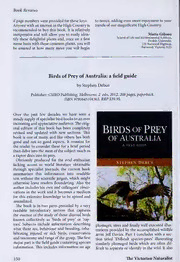
Birds of prey of Australia: A field guide [Book Review] PDF
Preview Birds of prey of Australia: A field guide [Book Review]
BookReviews ifpagenumberswereprovided forthesekeys. to notice,addingevenmoreenjoymenttoyour AnyonewithaninterestintheHighCountryis travelsofourmagnificentHighCountry. recommended to buythis book. It is relatively inexpensive and will allow you to easily iden- MariaGibson tifythese delightful plants and, once on a first SchoolofLifeandEnviroDnemaeknitnalUnSicvieernscietsy,, namebasiswiththesecommonplants,youwill 221BurwoodHighway, be amazed at how many more you will begin Burwood,Victoria3125 Birds ofPrey ofAustralia: a field guide byStephen Debus Publisher: CSIROPublishing Melbourne, 2 edn,2012.208pages,paperback. , ISBN9780643104365. RRP$39.95. Over the past few decades we have seen a steadysupplyofspecialistbirdbookstoanever increasingandappreciativeaudience. Theorig- inal edition ofthis book has been completely revised and updated with new sections. This book is one ofmany, and like others has both good and not so good aspects. It remains for the reader to consider these for a briefperiod then delveintothemeatofthesubjectmuchas araptordoesintoitsprey. Obviously produced for the avid enthusiast lacking access to world literature obtainable through specialist journals, the current book summarises this information into readable textwithoutthe scientificjargon, which might otherwise leave readers floundering. Also the author includeshis own and colleagues obser- vations in the work and it becomes a medium for this extensive knowledge to be spread and assimilated. The book is in two parts preceded by a very readable introductory section that captures the essence ofthe study ofthose diurnal birds known collectively as ‘birds of prey’ or ‘rap- tors’. Subjects include information describing plumages, sizes and finallywell executed illus- what these are, behaviour and breeding, reha- trations provided bythe accomplished wildlife bilitating injured or sick birds, conservation artist JeffDavies. Part 1 concludes with a sec- andtaxonomyandrangeofthegroup. Thefirst tion titled ‘Difficult species-pairs’ illustrating majorpartis the field guide containingspecies similarly plumaged birds which are often dif- information. This includes information on age ficultto separate or identifyin thewild. Italso 150 TheVictorianNaturalist BookReviews includes alargenumberofcolourimagesofall Those are the good points. The not so good species indicating patterns and colours attrib- aspects are (once again) the books size: unless utable to individual species which will surely youhaveabackpackitisadifficultsizetocarry aidandassistobservers. ifitreallyisintended tobea‘fieldguide’. With- Part 2 constitutes a handbook providing de- in the pages there is repetition and the author tailabouteachspecies. Birds areseparatedinto appears to have a long-held grievance against nine subgroups, each having an introduction windfarms. These modern engineering devel- followed bydetailed information not included opmentsaredottingthelandscapeinareasalso within Part 1. Much has been previously pub- occupiedbybirdsofprey.Simply,thetwodonot lished,butthegemsarenewdata incorporated mixbutuntilproperstudies areconcluded itis within this text. As in the introductory para- notworthycontinuingtowriteonsubjectsthat graphs, information on characteristics, diet, have little basic study here in Australia. Firm behaviour and threats and conservation are evidence should be obtained and published to presented, although now these comments are back up future comments. Page 58 has a sec- directedtoindividualsubgroups/species. tion ‘Unconfirmedvagrants’. I oftenseesimilar BirdsofPreyofAustraliaconcludeswithchap- sectionsinbooksandarticlesofferinginforma- terssummarisingitscontentandlistingnumer- tion on what was or might be (I am guilty of ousreferences.The 13chapterscoveraspectsas it myself). Surely these species can be ignored varied as conservation, human impacts, pests until substantive confirmation is obtained, for andpollution. Aglossaryandliteraturelistfol- instanceastandard similartotheinternational low, eachwellresearched and presented. Over- convention that ifan animal hasn’t been seen allthebooksuppliesawelcomingmarketandis for 50 years it is considered to be extinct. The avolume thateveryavidbirdresearcher (ama- obvious erroneous record of Butastur teesa teur orprofessional) should havereadilyavail- could be removed; ifanother appears then by able.Informationiseasilygleaned;illustrations allmeansreintroducetheoriginalrecord. coverallaspectsoffieldidentification andpro- vide extremely useful information at home or NWLongmore work—especially where injured birds are pre- BirdSection,MuseumVictoria sentedforrehabilitation. Thepriceiscompara- MelGbPoOurBnoex3060616 ble to that ofsimilar works on other subjects andisnotdaunting. Itisaworthyreplacement forthefirstedition. Australian Lizards: A Natural History bySteve KWilson Publisher: CSIROPublishing, Collingwood, Victoria, 2012. 196pages,paperback, colourillustrations. ISBN9780643106406. RRP$49.95 A childhood encounter with a lizard made an Wilsonistheauthorofseveralbooks,mostno- indelible impression on Steve Wilson, as it has tablythenationalfieldguideA CompleteGuide done for many kids. That this quickly turned toReptiles ofAustralia, which is updated every into a passion, and thence into obsession, was fewyears to keep up with the latest taxonomi- undoubtedlyfacilitatedbythefact,demonstrat- cal changes. In effect, that book is the (neces- ed earlyinhislatestbookAustralian Lizards: a sarily clinical) identification guide to Austral- naturalhistory,thatlizardscanbefoundalmost ian reptiles, whilst this latest book provides everywhere in this country, except in the most theintriguingdetailsthatunderpinthelives of urbanised southerncities. theseanimals.Asuperbphotographer,Wilson’s Vol 130 (1) 2013 151
